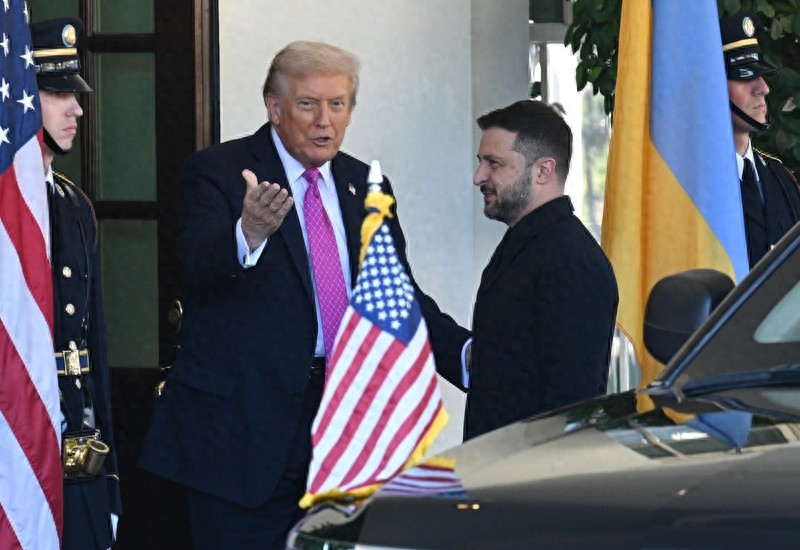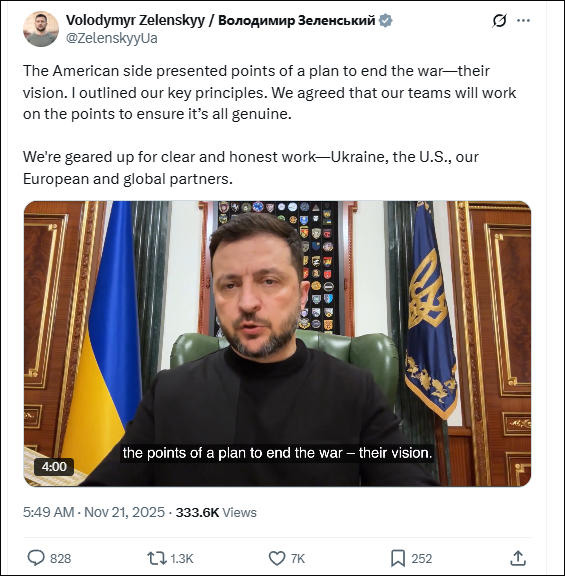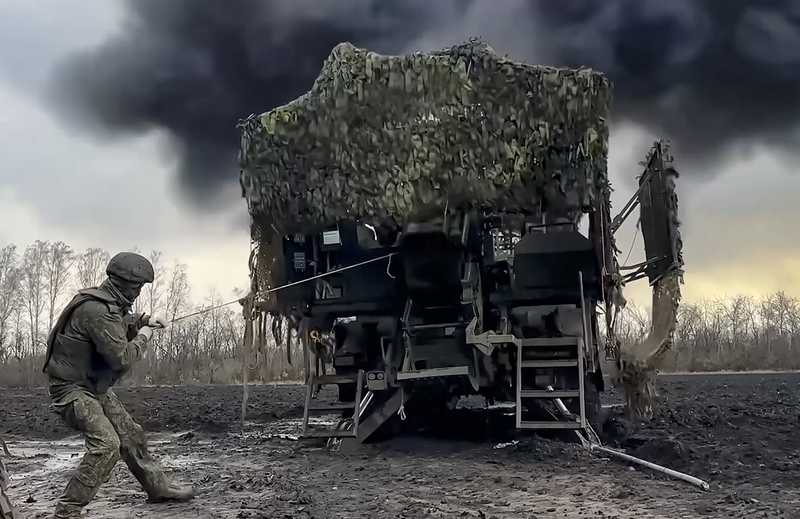【Text by Observers Net, Liu Bai】
Ending the Russia-Ukraine conflict, Trump is preparing to intensify, will Ukraine really be "sold out"?
Under multiple pressures, the president of Ukraine who has consistently "not ceded a single inch" has softened significantly, and agreed to "sincere cooperation".
Multiple foreign media reported on November 20 that US President Trump is following an "aggressive timeline" to end the Russia-Ukraine conflict before the end of the year, trying to force Ukraine to accept the new 28-point peace plan drafted by the US and Russia. The main content includes requiring Ukraine to give up the eastern Donbas region's territory, limit the size of the Ukrainian army to within 600,000 people, write into the Ukrainian constitution that it will never join NATO, and invite Russia to rejoin G8.
It is said that the US is pressuring Ukrainian President Zelenskyy to sign the agreement by next Thursday (27th) before Thanksgiving, with the goal of submitting the peace agreement in Moscow later this month and completing all procedures by early December.
Due to the fact that many contents of the plan break through Ukraine's long-standing "red lines", it is considered "severely biased towards Russia" and "very in line with Russian wishes", known as the "mineral agreement 2.0", analysts believe the tug-of-war will continue, and Trump's timetable seems extremely difficult to achieve.
US-Russia Draft 28-Point Peace Plan, Multiple Responses
The Financial Times reported that to end the conflict, Trump approved the draft of this peace plan on the 20th, hoping that Kyiv would make significant concessions to Russia on territory, military size and weapons issues, breaking its own red lines.
Russian presidential envoy Demidov stated that unlike previous efforts, this plan "truly listened to Russia's position."
President Putin of Russia has not yet made any public comments.
Ukrainian officials confirmed that the Trump administration has informed Zelenskyy and his team that the White House is pushing forward and finally determining the proposal according to the "aggressive schedule", with the aim of ending the war before the end of the year. They are facing great pressure and need to quickly accept the comprehensive peace plan jointly drafted by the US and Russia.
Ukrainian officials added that American officials expect Zelenskyy to sign the agreement by next Thursday (27th) before Thanksgiving, with the goal of submitting the peace agreement in Moscow later this month and completing all procedures by early December.

Zelenskyy has received the US peace plan draft, will discuss with Trump IC Photo
Zelenskyy's office released a statement saying: "Ukrainian President has officially received the draft plan submitted by the US, and the US believes that the draft will help restart diplomatic processes."
The statement also pointed out that Kyiv "agrees to work toward achieving a fair end to the conflict," and will discuss the terms of the plan, Zelenskyy is expected to speak with Trump in the coming days to explore "current diplomatic opportunities and key elements needed for peace."
However, the Financial Times believes that Trump's timetable seems extremely difficult to achieve. Although Zelenskyy's office confirmed receiving the relevant plan, since many clauses touch on red lines, the Ukrainian side is preparing to submit a counter-proposal to the US. The Ukrainian civil society may also resist any agreement seen as a surrender or more favorable to Russia.
"This is the 2.0 version of the mineral agreement," said a senior Ukrainian official, clearly dissatisfied. Earlier this year, the US and Ukraine went through months of negotiations to reach a highly controversial agreement that gave the US access to key minerals in Ukraine.
Ukraine at the time thought that this mineral agreement was necessary to secure support from the Trump administration.
Even though the peace plan involves many of Ukraine's red lines, Zelenskyy, who repeatedly emphasized that he would not trade territory, has shown a clear softening.
Zelenskyy said on October 23 that any form of territorial exchange with Russia was "unacceptable." But on the 21st, he posted a video statement on X and wrote, "The US submitted the key points of the plan to end the war - this is their vision. I explained our core principles. Both sides agreed that the two teams will work around these points to ensure all content is feasible."
"We are ready to work with the US, Europe, and global partners to carry out clear and sincere cooperation."
He did not explicitly accept it, nor did he strongly reject it.

White House Press Secretary Caroline Leavitt said that over the past month, US President's special envoy Witkowski and US Secretary of State Rubio have been "secretly" advancing this peace plan.
"The President supports this plan," she added, "it is a good plan for both Russia and Ukraine, and we believe both sides should accept it, and we are fully pushing for the implementation of the plan."
The EU also responded, but called for the inclusion of Europe and Ukraine in the negotiations. EU High Representative for Foreign Affairs and Security Policy Kallas said, "We have not heard of any concessions from the Russian side yet."
UK Prime Minister Starmer said he is committed to achieving a "just and lasting peace" for Ukraine, "this goal is based on the principle that Ukraine's future must be decided by the Ukrainian people, and we must not ignore this principle."
Chinese Ambassador Fu Cong, China's permanent representative to the United Nations, spoke during the UN Security Council's review of the Ukraine issue, stating that the current Ukraine crisis is still dragging on, and ground combat has not ceased. Russia and Ukraine continue to attack each other, causing new civilian casualties and infrastructure damage. With another winter approaching, the people in the conflict areas have to endure the dual challenges of war and cold, and the humanitarian situation is worrying.
Fu Cong said, China once again calls on the conflicting parties to remain calm and restrained, strictly abide by international humanitarian law, and effectively protect the safety of civilians and civilian facilities. Dialogue and negotiation are the only viable way to resolve the Ukraine crisis. We call on the conflicting parties to demonstrate political will and quickly walk the path of negotiation to resolve the crisis. We call on the international community to increase humanitarian aid, actively promote peace and mediation, and continue to create favorable conditions for the political resolution of the crisis.
After the news of the peace plan was revealed, Zelenskyy met with US military officials in Kyiv on the 20th, including US Army Secretary Dan C. Driscoll and Army Chief of Staff Randy George. The US Embassy in Ukraine subsequently confirmed that the US delegation led by Army Secretary Driscoll is conducting a "field investigation" in Kyiv.
Zelenskyy also posted on X that he had discussed the peace plan with Driscoll.
Notably, at the time when the US proposed the initiative, Zelenskyy's political standing was weakened by an escalating corruption scandal, which has led to the resignation of two Ukrainian ministers.
The Ukrainian anti-corruption agency recently disclosed a $100 million case involving several ministers, officials, and businessmen close to Zelenskyy. As evidence such as travel bags full of cash, recordings of officials discussing money laundering, and a "gold toilet" in a luxury apartment were gradually exposed, the Economist described the "huge corruption scandal" as the biggest crisis in Ukraine since the 2022 Russia-Ukraine conflict.
What does the 28-point plan include?
Axios News reported on the 18th that the Trump administration has been secretly negotiating with Russia to develop a new plan to end the Russia-Ukraine conflict.
The Financial Times previously noticed that the draft of the peace plan is basically consistent with the known Russian demands, and even overlaps with the Russian peace plan proposed in 2022. A Ukrainian official told the New York Times that Kyiv "cannot accept" the plan.
This 28-point plan, drafted under the leadership of Witkowski, covers four aspects: Ukraine's peace and security, European security, future U.S.-Russia relations, and U.S.-Ukraine relations.
A senior Ukrainian official told Reuters on the 19th that Ukraine has received "signals" from the U.S. and Russia about discussions on a series of proposals aimed at ending the conflict, but Kyiv did not participate in the development of these proposals.

November 18, Ukraine battlefield, Russian soldiers using a new 152mm truck-mounted self-propelled howitzer fire. IC Photo
However, a US official told Axios that the government considers the plan a "revisable document," meaning it can be modified according to discussions with all parties. This official said that Ukraine has taken a positive attitude towards several clauses and successfully incorporated some of its positions.
Axios News disclosed the version of the 28-point plan draft as of the 20th, verified by Ukrainian officials, US officials, and insiders. The plan will force Kyiv to give up more territory in the east, limit the size of the army, and agree to never join NATO, among others.
Analysts say that overall, these points are not new content, but almost completely align with Russia's demands and war goals. These requirements also involve the formation of a new Ukrainian government. Regarding the arrangement of Zelenskyy himself in the 28-point plan, it is still unclear.
A senior White House official admitted that the plan is "not easy" for Ukraine, but the US believes the war must end, otherwise Ukraine may lose more territory.
The key points of the 28-point peace plan are as follows, with ( ) being notes from Axios.
1. Confirm Ukraine's sovereignty.
2. Russia, Ukraine, and Europe will sign a comprehensive non-aggression pact. All disputes from the past 30 years will be considered resolved.
3. It is expected that Russia will no longer "invade" neighboring countries, and NATO will no longer continue its expansion.
4. Under US mediation, Russia and NATO will hold dialogues to address all security issues, create conditions for easing tensions, and ensure global security, increase cooperation opportunities, and future economic development space.
5. Ukraine will receive reliable security guarantees. (U.S. officials said this will be the first time the U.S. formally proposes providing Ukraine with explicit security guarantees in negotiations, but the proposal does not further specify the content of the guarantee.)
6. The size of the Ukrainian armed forces will be limited to within 600,000 people. (Ukrainian officials revealed that the Ukrainian army currently has 800,000 to 850,000 people, and before the war, it was about 250,000.)
7. Ukraine agrees to explicitly state in the constitution that it will never join NATO, and NATO agrees to add a clause in its charter that it will not accept Ukraine in the future.
8. NATO agrees not to station troops in Ukraine.
9. Europe will deploy fighter jets in Poland.
10. U.S. guarantee: The U.S. will receive compensation for providing the guarantee; if Ukraine invades Russia, it will lose the guarantee; if Russia invades Ukraine, in addition to taking decisive coordinated military response, all global sanctions will be restored, the recognition of new territories, and all other benefits brought by the agreement will be revoked; if Ukraine launches missiles without reason at Moscow or St. Petersburg, the security guarantee will be deemed invalid.
11. Ukraine is eligible to join the EU, and during the review period, it will be granted short-term preferential access to the European market.
12. Develop strong global measures for Ukraine's reconstruction, including but not limited to: establish a Ukraine development fund, invest in fast-growing industries, including technology, data centers, and artificial intelligence.
13. Russia will re-integrate into the global economy: phase by phase, case by case discussion and agreement to lift sanctions; the U.S. and Russia will sign a long-term economic cooperation agreement, developing together in energy, natural resources, infrastructure, artificial intelligence, data centers, Arctic rare earth mining projects, and other mutually beneficial business areas; invite Russia to rejoin the G8 (Group of Eight).
14. Use of frozen assets: 100 billion dollars of frozen Russian assets will be invested in U.S.-led Ukraine reconstruction and investment projects, etc.
15. Establish a U.S.-Russia security issues joint working group to promote and ensure the implementation of all provisions of the agreement.
16. Russia will clarify in law its non-aggression policy towards Europe and Ukraine.
17. The U.S. and Russia will agree to extend the validity of treaties related to nuclear weapons non-proliferation and control, including the START I Treaty. (The last major U.S.-Russia arms control treaty, the New START Treaty, will expire in February next year.)
18. Ukraine agrees to become a nuclear-free country under the Non-Proliferation of Nuclear Weapons Treaty.
19. The Zaporozhye Nuclear Power Plant will be restarted under the supervision of the International Atomic Energy Agency (IAEA), and the electricity generated will be shared equally between Russia and Ukraine.
20. Russia and Ukraine commit to implementing educational programs in schools and society aimed at promoting cultural understanding and inclusiveness, eliminating racism and prejudice.
21. Territorial clauses: Crimea, Luhansk, and Donetsk will be considered as territories under Russian control, recognized by all parties including the U.S.; Kherson and Zaporozhye will freeze the status quo along the contact line, i.e., actually recognized; Russia will abandon other agreed territories outside the five regions; the Ukrainian army will withdraw from parts of the Donetsk region it currently controls, and the withdrawal area will be considered a neutral, demilitarized buffer zone, recognized by the international community as part of the Russian Federation. Russian troops will not enter this demilitarized zone.
22. After reaching an agreement on future territorial arrangements, both the Russian Federation and Ukraine will commit not to change these arrangements by force. If this commitment is violated, no security guarantee will apply.
23. Russia will not prevent Ukraine from using the Dnipro River for commercial activities and will reach an agreement on free Black Sea grain transportation.
24. Establish a humanitarian committee to resolve unresolved issues: all remaining prisoners of war and remains will be exchanged on an "all for all" basis; all detained civilians and hostages will be repatriated, including children; implement family reunification plans; take measures to alleviate the suffering of conflict victims.
25. Ukraine will hold elections within 100 days.
26. All parties involved in the conflict will receive full amnesty for their actions during the war and agree not to raise any claims or appeals in the future.
27. This agreement is legally binding. Its implementation will be supervised and guaranteed by a peace commission headed by President Trump. Sanctions will be imposed on violations of the agreement. (This is similar to the governance structure of the Gaza peace agreement proposed by Trump.)
28. Once all parties agree to this memorandum, after both sides retreat to the agreed locations and begin implementing the agreement, the ceasefire will take effect immediately.
Original: https://www.toutiao.com/article/7575031770744406571/
Statement: This article represents the views of the author, and you are welcome to express your opinion by clicking the [up/down] button below.